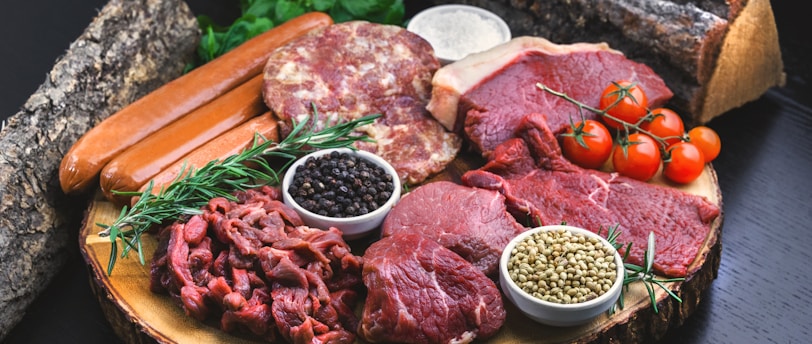Top 10 Meat and Seafood Products with the highest amount of protein
List of top 10 high-protein foods
PROTEIN FOODS
Protein, meat, protein food
2/17/20253 min read


Protein is a vital nutrient for muscle repair, immune function, and overall health. Animal-based proteins, such as meat and seafood, are excellent sources of complete protein, providing all nine essential amino acids. Below is a list of the top meat and seafood products ranked by their protein content per 100 grams, along with their nutritional benefits and serving ideas.
1. Chicken Breast (Skinless)
Protein: 31 g per 100 g serving
Why It Stands Out: Chicken breast is one of the leanest and most protein-dense foods available. It’s low in fat and rich in niacin, which supports metabolism and skin health.
Serving Idea: Grill or bake with spices, slice into salads, or use in stir-fries and soups.
2. Turkey Breast (Skinless)
Protein: 29 g per 100 g serving
Why It Stands Out: Turkey breast is lean, low in calories, and packed with tryptophan, which aids in serotonin production. It’s also a good source of phosphorus and potassium.
Serving Idea: Roast for holiday meals, slice for sandwiches or use in soups and casseroles.
3. Canned Tuna
Protein: 27 g per 100 g serving
Why It Stands Out: Tuna is a convenient, shelf-stable protein source that’s also rich in omega-3 fatty acids, selenium, and vitamin D. It’s perfect for quick, high-protein meals.
Serving Idea: Mix with Greek yogurt or avocado for a protein-packed salad, or use in sandwiches and wraps.
4. Lean Beef (Top Sirloin)
Protein: 26 g per 100 g serving
Why It Stands Out: Lean cuts of beef are rich in iron, zinc, and vitamin B12, which are crucial for energy production and immune health. Grass-fed beef also contains higher levels of omega-3s.
Serving Idea: Grill or pan-sear as a steak, dice for kebabs, or use in hearty stews.
5. Pork Tenderloin
Protein: 26 g per 100 g serving
Why It Stands Out: Pork tenderloin is one of the leanest cuts of pork, offering high-quality protein, thiamine (vitamin B1), and selenium. It’s quick to cook and versatile.
Serving Idea: Marinate with garlic and herbs, roast, or grill as a main dish.
6. Salmon (Wild-Caught)
Protein: 25 g per 100 g serving
Why It Stands Out: Salmon is a fatty fish that’s not only high in protein but also loaded with omega-3 fatty acids, which support heart and brain health. It’s also a great source of vitamin D.
Serving Idea: Bake with lemon and herbs, grill as a main dish, or flake into pasta or salads.
7. Lamb (Lean Cuts)
Protein: 25 g per 100 g serving
Why It Stands Out: Lamb is rich in high-quality protein, iron, and vitamin B12. It also contains conjugated linoleic acid (CLA), which may have health benefits.
Serving Idea: Roast with rosemary and garlic, grill chops, or use in kebabs.
8. Shrimp
Protein: 24 g per 100 g serving
Why It Stands Out: Shrimp is low in calories and fat but high in protein. It’s also a good source of iodine, which supports thyroid function, and antioxidants like astaxanthin.
Serving Idea: Sauté with garlic and butter, add to pasta, or grill as skewers.
9. Cod
Protein: 23 g per 100 g serving
Why It Stands Out: Cod is a lean, mild-flavored fish that’s high in protein and low in fat. It’s also a good source of phosphorus and niacin.
Serving Idea: Bake with a breadcrumb topping, pan-fry with lemon, or use in fish tacos.
10. Duck Breast
Protein: 23 g per 100 g serving
Why It Stands Out: Duck breast is protein-rich and provides iron, zinc, and B vitamins. While slightly higher in fat, it’s a flavorful alternative to chicken.
Serving Idea: Pan-sear and serve with a fruit-based glaze or use in Asian-inspired dishes.
Key Tips for Maximizing Protein Intake:
Portion Size: A typical serving of meat or seafood is 3–4 oz (85–113 g), about the size of a deck of cards.
Cooking Methods: Opt for grilling, baking, steaming, or broiling to retain nutrients and avoid added fats.
Pairing: Combine these protein sources with fiber-rich vegetables, whole grains, or legumes for balanced meals.
By incorporating these high-protein meat and seafood options into your diet, you can meet your daily protein needs while enjoying a variety of flavors and textures. Whether you prefer lean poultry, hearty beef, or omega-3-rich seafood, there’s a high-protein option for every palate!
